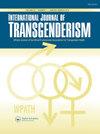Relationship among gender-related stress, resilience factors, and mental health in a Midwestern U.S. transgender and gender-nonconforming population
Q1 Social Sciences
引用次数: 39
Abstract
ABSTRACT Background: Transgender and gender-nonconforming individuals experience more discrimination than their cisgender peers, and this discrimination can be associated with poorer mental health. This study used the gender minority stress model as a framework to examine the relationship among gender-related stressors and resilience factors and mental health outcomes. The study particularly aimed to increase knowledge of the gender-nonconforming population. Methods: A community sample of 83 individuals that identify as a gender different than the sex assigned to them at birth completed an online survey. Depression and anxiety were assessed using the Center for Epidemiological Studies Depression Scale (CES-D) and Beck Anxiety Inventory (BAI), respectively. The Gender Minority Stress and Resilience measure was used to assess distal and proximal stressors and resilience factors. Results: The median CES-D and BAI scores were 16 and 13, respectively. Forty percent had a history of non-suicidal self-injury (NSSI), 75% had experienced suicidal ideation, and 45% had attempted suicide. Proximal stress was found to be a positive predictor of depressive symptoms. Resilience was a weak negative predictor of anxiety symptoms. Distal stress was a positive predictor of suicide attempts, and resilience factors and hormone use were marginal negative predictors of suicide attempt. Trans women were significantly less likely to have engaged in NSSI, but had a significantly higher proximal stress score than trans men and gender-nonconforming individuals. Conclusion: Our study found high rates of mental health problems in the trans and gender-nonconforming sample. Our findings in part support the gender minority stress model, with gender-related stress predicting certain mental health problems and resilience being a negative predictor. Overall, gender-nonconforming individuals have had similar experiences and mental health findings as transgender individuals.美国中西部跨性别和性别不一致人群中性别相关压力、恢复力因素和心理健康的关系
背景:跨性别和性别不一致的个体比他们的顺性别同龄人遭受更多的歧视,这种歧视可能与较差的心理健康有关。本研究以性别少数群体压力模型为框架,探讨性别相关压力源和心理弹性因素与心理健康结果的关系。这项研究特别旨在增加对性别不一致人群的了解。方法:一个社区样本的83个人的性别认同不同于出生时分配给他们的性别完成在线调查。抑郁和焦虑分别采用流行病学研究中心抑郁量表(CES-D)和贝克焦虑量表(BAI)进行评估。采用性别少数群体应激和恢复力量表评估远端和近端应激源和恢复力因素。结果:ce - d和BAI中位数分别为16分和13分。40%的人有非自杀性自伤史,75%的人有过自杀意念,45%的人有过自杀未遂。发现近端压力是抑郁症状的积极预测因子。恢复力是焦虑症状的弱阴性预测因子。远端压力是自杀企图的正向预测因子,而弹性因素和激素使用是自杀企图的边际负向预测因子。跨性别女性发生自伤的可能性显著低于跨性别男性和性别不符合者,但近端压力得分显著高于跨性别男性和性别不符合者。结论:我们的研究发现,在跨性别和性别不一致的样本中,心理健康问题的发生率很高。我们的研究结果在一定程度上支持了性别少数派压力模型,与性别相关的压力预测某些心理健康问题,而弹性是负面预测因素。总的来说,性别不一致的人与跨性别者有着相似的经历和心理健康发现。
本文章由计算机程序翻译,如有差异,请以英文原文为准。
求助全文
约1分钟内获得全文
求助全文
来源期刊

International Journal of Transgenderism
Social Sciences-Gender Studies
CiteScore
5.10
自引率
0.00%
发文量
0
期刊介绍:
International Journal of Transgenderism, together with its partner organization the World Professional Association for Transgender Health (WPATH), offers an international, multidisciplinary scholarly forum for publication in the field of transgender health in its broadest sense for academics, practitioners, policy makers, and the general population.
The journal welcomes contributions from a range of disciplines, such as:
Endocrinology
Surgery
Obstetrics and Gynaecology
Psychiatry
Psychology
Speech and language therapy
Sexual medicine
Sexology
Family therapy
Public health
Sociology
Counselling
Law
Medical ethics.
 求助内容:
求助内容: 应助结果提醒方式:
应助结果提醒方式:


